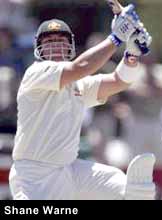Martyn to the rescue
Daniel Laidlaw
Damien Martyn stroked his third Test century to lead yet another Australian
lower order fightback as the home team emerged on top after day two of the
first Test against South Africa.
Martyn, who remained unbeaten on 124 not out, was involved in partnerships
of 86 and 77 for the seventh and eighth wickets with Shane Warne and Brett
Lee respectively as Australia recovered the ground its middle order lost to
post a commanding total of 439. Glenn McGrath then prised out the wickets of
the Kirsten and Dippenaar in the last session as South Africa finished on
101/2.
One day, Australia’s lower order will not save them when required, and 250/6
will become 280 all out rather than 400. For now, though, they had to do it
again.
 Pollock and Hayward began with a ball just six overs old and Warne, in the
batting form of his career, greeted them with typical boisterous aggression.
Hayward, with his varied length, was the easier of the two to hit, but not
for Martyn. With a standing cover drive that is pure timing, Martyn was able
to stroke Pollock away a couple of times in a gloriously dismissive fashion
reminiscent of VVS Laxman at his best.
Pollock and Hayward began with a ball just six overs old and Warne, in the
batting form of his career, greeted them with typical boisterous aggression.
Hayward, with his varied length, was the easier of the two to hit, but not
for Martyn. With a standing cover drive that is pure timing, Martyn was able
to stroke Pollock away a couple of times in a gloriously dismissive fashion
reminiscent of VVS Laxman at his best.
Pollock probed away on off stump and Hayward tried to blast out wickets,
with Warne showing an inclination to hook both. Martyn was mostly assured
and studied in defence, playing the bowling on its merits and encouraging
Warne to do likewise. Warne could have been run out half an hour in when he
was rightly sent back looking for a single to square leg, but Dippenaar’s
throw missed. Although he lived dangerously, Warne’s aggression made it
Australia’s morning and gave them the advantage again.
Warne took full toll of Hayward when the blonde quickie strayed, cracking
three consecutive fours by pulling, thrashing through cover and then pulling
again. With his accurate bouncer, Pollock was much harder to hook, but Warne
went for him anyway, with one shot falling just out of reach of a superb
diving effort by Hayward running around from fine leg.
Klusener replaced Hayward and like day one, South Africa began to exercise
more control upon his introduction. Klusener had a driving Warne dropped at
second slip by Kallis, who got both hands to the ball in a tough chance
diving to his right that didn’t stick. Pollock also went close to dismissing
Warne but just could not find an edge to a fielder, and the frustration
showed.
When things don’t go well for South Africa, they start bowling wider of off
stump and fortify the off side field until composure is regained. After 60
runs were scored in the first hour, that’s what Klusener and Kallis did, and
it worked, though the breakthrough was not a result of that tactic.
Klusener struck first over after drinks, bowling Warne for 41 with a sharp
off-cutter from wide of the crease. The delivery jagged back off the pitch
and beat Warne for pace as he fell over, taking out middle stump to snap a
valuable partnership of 86 for the seventh wicket; Australia 332/7. Warne’s
cameo in conjunction with Martyn meant Australia had recovered sufficiently
to again ensure they felt comfortable with their position on a pitch playing
the occasional trick.
 Kallis and Klusener proved testing for the batsmen, but examined their
patience more than anything else. Lee, who with Warne has given Australia’s
tail some sting of its own, was in prime form, but most of his well-struck
shots only found the containing field and the scoring rate slowed. Kallis
and Klusener pursued a fairly one-dimensional line just outside off stump to
both, which for Martyn presented very few difficulties and he was happy to
accumulate.
Kallis and Klusener proved testing for the batsmen, but examined their
patience more than anything else. Lee, who with Warne has given Australia’s
tail some sting of its own, was in prime form, but most of his well-struck
shots only found the containing field and the scoring rate slowed. Kallis
and Klusener pursued a fairly one-dimensional line just outside off stump to
both, which for Martyn presented very few difficulties and he was happy to
accumulate.
South Africa’s third bowling combination, Henderson and Ntini, was a little
more demanding, as Henderson forced the batsmen to decide whether or not to
attack him, which mostly they were unable to do against his clever flight
and protective field. Ntini started erratically before finding his range and
at lunch Australia were 363/7, with Martyn 77 and Lee 11. The session saw 91
runs scored for only the loss of Warne, as Australia positioned themselves
nicely.
With Ntini and Henderson continuing, Lee appeared fortunate not to be given
out caught behind off the bottom edge playing a late cut against the
spinner. Boucher and the South Africans went up instinctively but umpire
Venkat said no, which the TV gadgetry confirmed as correct.
Martyn and Lee were able to continue in a positive vein, as Henderson was a
little too short outside off. Lee, with his deft footwork against Henderson
and accomplished strokeplay by No. 9 standards, complemented Martyn well as
the latter seemingly did his best to fall short of a hundred. On 90, Martyn
sent a slashing cut off Ntini just above Pollock at gully, then on 95 did
not get it so high, dropped by Pollock to his right as he played another
airborne cut.
With those jitters behind him, Martyn duly raised his century (184 balls, 6
x 4) by glancing Henderson fine for two, his first on Australian soil. After
being dropped as a young player following a much-scrutinised failure against
South Africa in Sydney in 1994, Martyn’s career has turned full circle.
Lee’s competent cameo ended on 32, scooping a yorker-length Hayward slower
ball to McKenzie at mid off. Lee added a valuable 77 with Martyn for the
eighth wicket, departing with Australia in command at 409/8. Martyn then hit
out, striking three fours off one Henderson over including two swept to mid
wicket, as a humbled South Africa let the game drift and awaited mistakes.
Jason Gillespie provided one after making 3, skying a top edge trying to
sweep Henderson to the boundary which a nervy Boucher held after a late
adjustment. Glenn McGrath began like it was he and not his partner who was
100 not out, a few sweeps getting him to five. He was similarly ambitious
against Hayward before a word of caution from Martyn, only to be bowled next
ball playing over a Hayward slower ball on off stump.
Gillespie and McGrath let Martyn down somewhat, leaving him stranded on 124
not out, but Australia nevertheless had recovered in familiar fashion to an
imposing total of 439.
Interestingly, South Africa only have three batsmen who average above 40,
and with the unproven Dippenaar listed at five followed by the all-rounders,
there is something of a question mark over their batting below the top four.
Much depends on the top three with the 40+ averages – Gibbs, Kirsten and
Kallis – which lead to a testing period for the openers prior to tea.
Steve Waugh made an unexpected move by introducing Shane Warne after just
three overs, and the leg-spinner nearly made an instant impact when Kirsten
edged his first delivery just past the fingers of Mark Waugh at slip as he
drove square. Surviving that moment of alarm, Gibbs and Kirsten saw the
tourists through to 16/0.
Warne and Gillespie resumed after tea, with Gibbs and Kirsten confident in
their ability to handle both. Gillespie gradually built up pace but
generated no lateral movement and posed few problems for the batsmen.
Kirsten scored more freely than his partner as the Australians restricted
Gibbs by denying him freedom outside off, but apart from two ambitious pulls
that failed to connect, Gibbs and Kirsten were both comfortable.
Despite changing the bowlers, there was a general lack of intensity in the
Australian attack, as if they realised there was a lot of bowling ahead.
Gibbs and Kirsten steadily built their partnership and were rarely beaten,
with the only semblance of a chance arriving more than an hour into the
session. Gibbs sought a run to backward point and was belatedly sent back by
Kirsten, but Lee’s shot was off target.
McGrath, who had claimed he was bowling well and that his unproductive
series against New Zealand was an aberration, seemed to lack a sharp edge
despite bowling economically. Employing the same policy as the New
Zealanders, Kirsten and Gibbs took no risks against him, leaving as much as
they could and thus denying McGrath his productive edges.
With the batsmen having settled in for the long haul, it took a bizarre
piece of cricket to produce a wicket against the run of play. From around
the wicket, McGrath slipped out an inadvertent full toss which Kirsten
failed to sight, turning his head away as if expecting a beamer only to be
struck on the flap of the pad by the ball angling towards leg. Height was
not an issue and with Kirsten marginally in front of his crease it would
have taken the stumps, leaving South Africa 87/1 with Kirsten gone for 47.
It was Boeta Dippenaar rather than Kallis who entered at No. 3, and after
getting off the mark with a square driven boundary, fell to a sensational
momentum-shifting catch by Ricky Ponting at gully.
Dippenaar launched into a cracking back cut against McGrath and Ponting
reacted instinctively, barely having time to fling out his left arm to
clutch the catch of the season in one hand. The effort is best appreciated
in real time, so you can see just how quickly Ponting reacted, with the
fielders not having had time to finish yelling “catch!” by the time Ponting
had pouched it. Considering the chances South Africa let slip, including off
Ponting himself, it could make a telling difference.
Claude Henderson entered as nightwatchman and nearly departed first ball
after barely clamping down on a reverse-swinging McGrath yorker. McGrath
could not replicate the delivery and neither could Lee in the last over of
the day, as South Africa went in two down, Gibbs 42 not out, and trailing by
338. Australia will likely need to create and seize more moments of
opportunism if they are to achieve a significant first innings lead.
Match report: Day 1
Scorecard:
Australian 1st innings |
South African 1st innings
Images:
Day 1 | Day 2
Mail Daniel Laidlaw